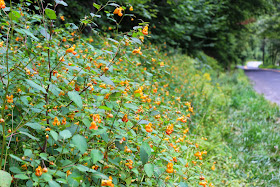We drove northwest for a couple of hours. And we stayed a couple of hours. A couple of days would have been ideal; we love this part of the Catskills.
But we squeezed out what we could. Stopping in tiny Grahamsville I popped into the impressive local museum for a bathroom break. Inside is an interactive exhibit about the water that is led from the Catskills to thirsty New York City - "Tunnels, Toil and Trouble " - worth a visit. In the small shop I bought a biography of John Burroughs, a Catskills man, author, nature essayist and source of dozens of pocket quotes."To learn something new, take the path that you took yesterday..."
The path we had taken yesterday was the road I had last seen in early spring when the trees were bare and the ditches were all leaf litter, dry gravel and the leggy stalks of colstfoot. It had been transformed into a jungling green. Those round leaves belong to the same - Tussilago farfara.
The stream that Vince loves and has photographed in yellow fall and icy April was shaded in brilliant green and a foot or so lower than earlier in the spring.
It was the last weekend of the American summer and we expected this round pool to be packed, but only three men came by, sank one by one into the freezing water, chattered at me as I read my new book, threatened jokingly to skinny dip (they stopped pretty fast when Vince appeared a few minutes later from the trees with the picnic) and then left, shivering and slipping a little on the rocks. I was chilly in my T-shirt.
Fall was apparent not in the leaves, but in the flowers. Asters, everywhere.
I'm not sure what the plant was above - I was sure it was escaped oregano, but it smelled wrong, more minty, and I did not take pictures of the leaves.
Solidago (golden rod) and asters crowded the narrow verges of the mountain road...
...with forests of beautiful jewelweed (Impatiens capensis).
Blackberries dripped from canes suspended from tree branches.
Up here there are still thimbleberries (Rubus odoratus, an indigenous shrub with rose-like flowers; also called purple flowering raspberry).
And rowan berries, or mountain ash, Sorbus americana, a native. Source them at a native nursery and plant them in your garden. Good for birds and people.
Pass on this one. Creepy doll's eyes on their optic nerve stalks. Actaea pachypodia's spring flower is very pretty, white and fluffy and smells like sweet lemons. The berries will make you veeeeeeeery sick. But a lovely Northeast perennial for a garden with dappled sunlight.
At this point the local sheriff pulled up beside us. He didn't like his narrow road being obstructed by a Zipcar, but was friendly enough. So we moved on and lower into the flatter lands and fields, where I spotted the one fruit I did stop to pick: autumn berry, or autumn olive - Elaeagnus umbellata. (Here's my essay about autumn olives, and what to do with them, for Edible Manhattan.)
They are super-invaders. So no guilty conscience, there. The ripest fruits taste a little like red currants. I love them. See the tiny silver speckles? Makes them easy to identify. The pale undersides of the leaves gives the trees a silvery-grey appearance from a distance. This could easily be a commercial crop - but I have never seen them sold at market. Have you?
So, that was the day's holiday. The Frenchman is laboring on Labor Day, and I will spend the day thinking about how impossible it is that it is already September.
My first wild edibles walk of the first fall month is next Sunday, the 7th, in Inwood Hill Park. We'll see how New York City's flora compares to the wilds north of us. I'm hoping some rain this week may raise mushrooms.














Thank that might be wild marjoram. Love to gather that in late summer.
ReplyDeleteYeah, that was my other thought, though I was was still confused by the smell. You are lucky to live in that part of our world, Laura.
DeleteDit lyk heerlik. Het jul ook geswem?
ReplyDeleteI've read that oregano and mint can cross pollinate.
ReplyDeleteRowan jelly! And a branch above the lintel and on the mantle will stop witches getting in!
ReplyDeleteHave you been to the top of Kaaterskill Falls ? Much less crowded with acres of woods to explore. GH
ReplyDelete